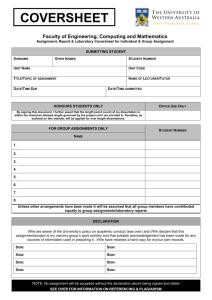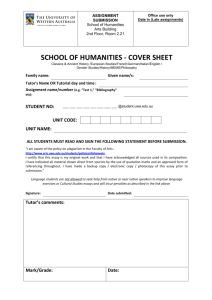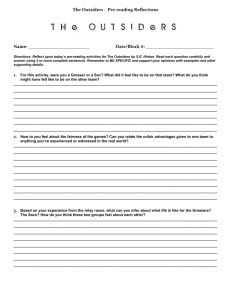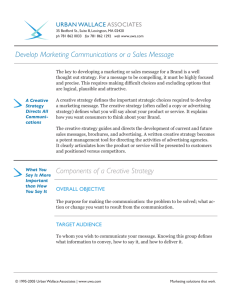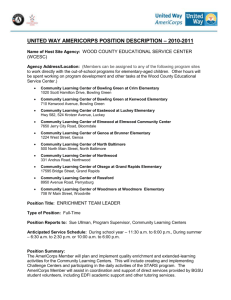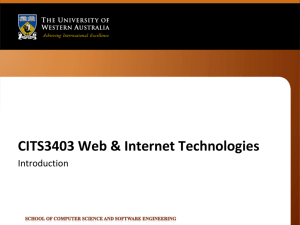Mergers & Acquisitions Summer Program 2009
advertisement
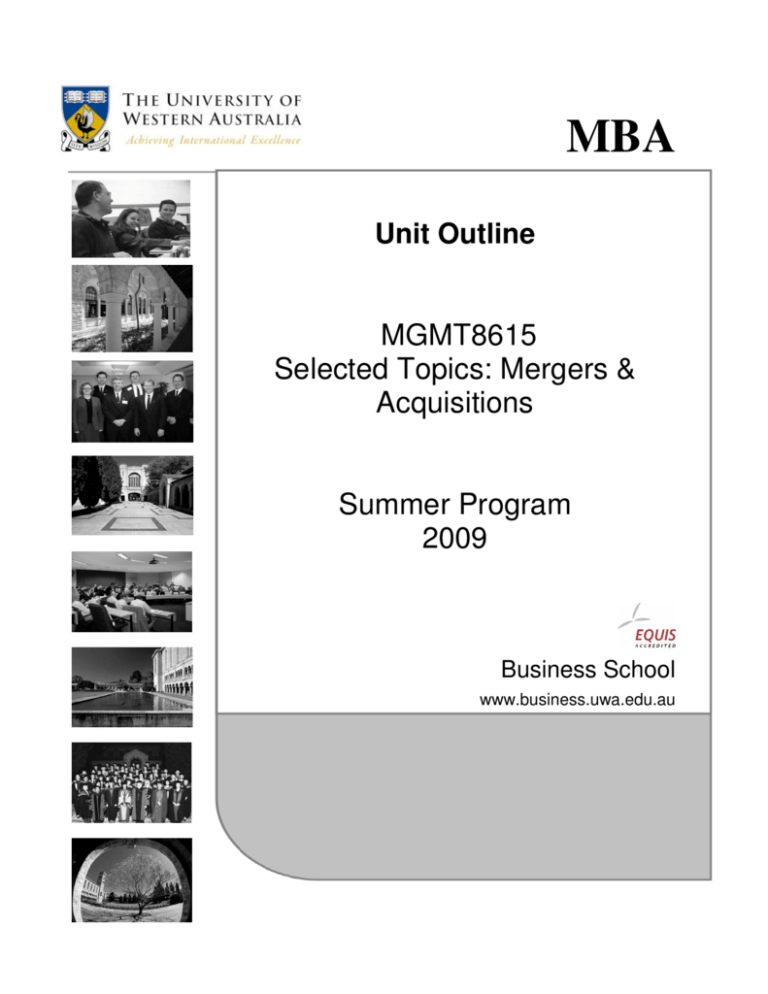
MBA Unit Outline MGMT8615 Selected Topics: Mergers & Acquisitions Summer Program 2009 Business School www.business.uwa.edu.au All material reproduced herein has been copied in accordance with and pursuant to a statutory licence administered by Copyright Agency Limited (CAL), granted to the University of Western Australia pursuant to Part VB of the Copyright Act 1968 (Cth). Copying of this material by students, except for fair dealing purposes under the Copyright Act, is prohibited. For the purposes of this fair dealing exception, students should be aware that the rule allowing copying, for fair dealing purposes, of 10% of the work, or one chapter/article, applies to the original work from which the excerpt in this course material was taken, and not to the course material itself. © The University of Western Australia 2007 Your Lecturer Raymond da Silva Rosa is a Professor at UWA Business School, Perth, Western Australia. Raymond wrote his PhD on the share market consequences of corporate takeovers and he has maintained a strong research interest in this area. He has developed and delivered lectures on M&As in the Masters program at the University of Sydney and the MBA program at Melbourne Business School, University of Melbourne. He has also taught at Stern Business School, New York University. Raymond has received three Australian Research Council large research grants related to M&As, including a current grant on the role of corporate boards in M&As, and has been commissioned by the Securities Institute of Australia to write reports on aspects of M&A regulation. He has also served as an expert witness in federal court cases involving takeover bids. Raymond has supervised six PhD students writing theses related to M&As. His publications in this area include the editorial review article (co-authored with Professor Terry Walter), “Australian mergers and acquisitions since the 1980s: What do we know and what remains to be done?” in the September 2004 special edition of the Australian Journal of Management on M&As. Raymond is also a co-author of “Investments” by Bodie, Ariff, Da Silva Rosa, Kane & Marcus (McGraw-Hill publishers, June 2007). Raymond’s other research interests include behavioural finance. (There is a surprisingly large overlap between behavioral finance and M&A, some of which will become apparent during the course.) He is currently working with BT Financial, a financial services organization, on factors influencing investors’ choice of managed fund. Raymond lectures in Corporate Finance and Advanced Corporate Finance at UWA. UNIT DESCRIPTION Introduction I enjoy researching and teaching about M&As. It is an intriguing subject that lends itself to rigorous analysis yet there remains a very human element to M&A implementation and execution that ensures analysis alone is insufficient to guarantee a happy outcome. In this course, I hope to show you the value and limits of rigorous analysis and also give you a sense of the excitement generated by M&As. Unit Objectives and Content The objectives of this subject are to enable students to: (a) Understand the basis for M&A transactions; (b) Identify the key issues in valuing M&A deals and the strengths and weaknesses of different valuation approaches (note important caveat in next paragraph); (c) Be acquainted with the regulatory framework of M&A and the implications for deal success; (d) Become familiar with the share market consequences of M&A, an important area for company managers, portfolio managers and active market trades. And, (e) develop a managers’ perspective on the drivers of M&A success via analysis and discussion of case studies. Valuation is an important parts of M&As and this unit will entail review of some Excel-based valuation models. However, the unit is NOT principally about valuing M&A deals via financial models. There are two reasons. One is that there are many different, important facets of M&A transactions many of which will be reviewed in the case studies. Focusing on financial valuation models to the extent required to develop a specialized expertise is not viable in a five-day long unit without leaving out material likely to be more relevant from a managerial perspective. The other reason is that financial models of M&A deal value are subject to considerable imprecision and the estimated values are highly contingent on market conditions. One implication of the imprecision in estimates of MA& deal value is that, in most cases, managers must base their decision with respect to M&A deals on relatively simple valuation models. Learning Outcomes On completion of this unit, you should be able to: (a) Understand the link between firm competencies and a M&A strategy. Many M&As fail because acquiring firms’ managers do not appreciate the drivers of value in their firm and the limits to those drivers in the context of an acquisition. (b) Value a firm from an M&A perspective. Desirable targets are those that may be purchased a price that leaves value for the acquirer. Acquirers surprisingly often forget this basic point. Techniques for “triangulating” estimates of value will be illustrated and pitfalls pointed out. (c) Identify the potentially problematic issues in an M&A deal from a regulatory perspective. The M&A market, in particular amongst listed companies, is highly regulated and fraught with litigation risk. One reason for being aware of regulatory concerns is to become a more informed client in the market for M&A advisers. (d) Apply your knowledge of key features of the M&A market to analysis of deals. The traps that many acquirers fall into provide opportunities for equity investors to capitalize by tailoring their portfolio accordingly. The lessons learned here are used by, amongst others, Dimensional Fund Advisers, the world-renowned fund management company, to select their portfolios. Key Dates Dates of submission of group case-study assignment and take-home exam to be finalized after consultation with the class on the first day of the course. UNIT STRUCTURE Seminar Topics There is no set textbook for this unit but most seminar sessions include selected readings. The ones marked “essential pre-reading” are just that. You will not be able to participate effectively in class if you have not read the essential pre-reading beforehand. Monday 12th Jan 09 Day 1 Session 1 Introduction; Key Issues in M&A 1. Three media articles on Mittal Steel’s Controversial Takeover Bid for Arcelor (Essential pre-reading) 2. Bruner, Robert F., 2004, “Where M&A Pays and Where It Strays: A Survey of the Research”, Journal of Applied Corporate Finance v16(4):63-76 3. Cools, K., J. Gell, J. Kengelbach & Alexander Roo, 2007, “The brave new world of M&A: How to create value from mergers and acquisitions” The Boston Consulting Group (3 August 2007, available from www.bcg.com; last accessed 6 August 2007) Day 1 Session 2 Case Study: Identifying value-drivers in specific M&As 4. Bruner, R., 1999, Three Active Acquirers Darden Business School Case (reference UVA-F-1255-SSRN) (Essential pre-reading) 5. Questions to address: Three Active Acquirers case Day 1 Session 3 Case Study: Valuation framework: The “value bridge” and analysis of synergy 6. Damodaran., A., 2005, Synergy, (Working Paper, Stern School of Business, New York University) 7. Mukherjee, Tarun K., Halil Kiymaz, and H. Kent Baker, 2004, “Merger motives and target valuation: A survey of evidence from CFOs” Journal of Applied Finance v14 (2):7-24. Day 1 Session 4 Valuation: Comparable companies method 8. Finnerty, J. D. & D. R. Emery, 2004, “The value of corporate control and the comparable company method of valuation” Financial Management v33(1):91-99 9. Liu, J, D. Nissim, & J. Thomas, March 2002, “Equity valuations using multiples” Journal of Accounting Research, v40(1): 135-172 Tuesday 13 Jan 09 Day 2 Session 1 Valuation: Discounted cash flow (DCF) method 10. McKinsey on Finance, “The real cost of equity” Perspectives on Corporate Finance and Strategy, No 5., Autumn 2002. Day 2 Session 2 Valuation: Case illustration 11. Weston, F., 2002, “The Exxon-Mobil Merger: An Archetype” Journal of Applied Corporate Finance pp. 69-88 Day 2 Session 3 Combining strategy and valuation: Radio One case study 12. Ruback, R. & P. Fischer, 2003, Radio One, Inc Harvard Business School Case (reference: 90201-025) Essential pre-reading 13. Questions for Class Discussion: Radio One case Essential pre-reading Day 2 Session 3 Valuation: An overview Further materials (if any) to be provided. This session will review particularly challenging materials covered earlier and also to address queries related to the group assignment (case distributed earlier in the day). Wednesday 14 Jan 09 Day 3 Session 1 M&A & Firm Strategy 14. Ghemawat, Pankai and Jamie L. Matthews, 2004 (revised), The Globalization of Cemex Harvard Business School Case (Product No 9-701-017). Essential pre-reading 15. Montgomery, C., 2005, Newell Company: Corporate Strategy Harvard Business Review Case (Product 9-799-139) Day 3 Session 2 Pitfalls in M&A Implementation 16. Kaplan, S.N., Mitchell, M.L. and Wruck, K.H., 1997, "A clinical exploration of value creation and destruction in acquisitions: Organization design, incentives, and internal capital markets" Center for Research in Security Prices (CRSP) Working Paper No. 450. http://ssrn.com/abstract=10995. Day 3 Session 3 M&A & Professional Services Firms 17. Groysberg, B & R. Abrahams, 2006, Duane Morris: Balancing Growth and Culture at a Law Firm Harvard Business School Case (Product No 9-407-025) Essential prereading Day 3 Session 4 M&A & Professional Services Firms (cont’d) 18. Beaulieu, N., B. Groysberg & K.T. Doherty, 2007, Furman Selz LLC(A): A Tale of Two Acquisitions Harvard Business School Case (Product No. 9-905-066) Essential prereading Monday 19 Jan 09 Day 4 Session 1 Diversification or Focus? 19. Baker, George P., 1992, “Beatrice: A study in the creation and destruction of value” Journal of Finance v47: 1081-1119 Essential pre-reading 20. Khanna, T., & K. Palepu, 1997, “Why focused strategies may be wrong for emerging markets” Harvard Business Review (July-August):41-51 Day 4 Session 2 Diversification or Focus? 21. Da Silva Rosa, R., N. Meemeduma & I. Watson, 2006, “Wesfarmers: The challenges of pursuing shareholder value in a conglomerate” Working Paper UWA Business School. Essential pre-reading Day 4 Session 3 Private Equity 22. Baker, G. P., and K. H. Wruck, 1989, “Organizational changes and value creation in leveraged buyouts: The case of O.M. Scott & Sons Company” Journal of Financial Economics, v25:163-190. Essential pre-reading 23. Jensen, M., et al, 2006, “Morgan Stanley roundtable on private equity and its import for public companies” Journal of Applied Corporate Finance v18(Summer 3):8-37 Session 4 The Global Financial Crisis and M&A Activity Readings to be advised Tuesday 20 Jan 09 Day 5 Session 1: M&A regulation: Review of Law and Issues for Managers 24. Miscellaneous media articles on M&A regulation (Essential pre-reading for class discussion) 25. Bugeja, Martin and Raymond da Silva Rosa, 2006, “Raising the takeover threshold in Australia: Issues and evidence” JASSA Autumn (issue 1): 33-38 Day 5 Session 2: Factors Influencing the Success of M&A Bids for ASX companies; Merger Arbitrage 26. Maheswaran, K., & S.C. Yeoh, 2005, “The profitability of merger arbitrage: Some Australian evidence” Australian Journal of Management v30(1):111-126. Day 5 Session 3: M&A: A Practioner’s Perspective Practitioner presentation – Speaker to be advised Day 5 Session 4: Review of Course Summary Overview of Course Content in Each Session MONDAY 12TH JAN TUESDAY 13TH JAN WEDNESDAY 14TH JAN MONDAY 19TH JAN TUESDAY 20TH JAN 8:30 - 10:30 Session 1 (2 hours) 10:30 – 10:45 morning tea Introduction; Key Issues in M&A DCF, Estimating cost of capital; Sensitivity M&A & Firm Strategy: Cemex case Newell case Diversification or focus? Beatrice case M& Regulation: Issues for Managers 10:45 – 12:30 Session 2 (1 hr 45 minutes) Identifying valuedrivers: “Three Active Acquirers” case Valuation: ExxonMobil takeover illustration Pitfalls in M&A implementation: Kaplan, Mitchell & Wruck 1997 Conglomerates: Wesfarmers case Merger arbitrage: Factors Influencing the Success of M&A Bids 12:30 – 1:15 Lunch 12:30 – 1:15 Lunch 1:15 – 3:00 Session 3 (1 hr 45 minutes) 3:00-3:15 – Afternoon Value bridge; Analysis of Synergy Valuation & Strategy– Radio One case M&A & Service Firms: Duane Morris: Balancing Growth & Structure at a Law Firm case Private equity: Business Model & Critique tea 3:15 – 4:30 Session 4 (1 hr 15 minutes) Example: Comparable companies technique Review of valuation M&A & Professional Service Firms (cont’d) Global Financial Crisis & M&A Activity Attendance Participation in class, whether it be listening to a lecture or getting involved in other activities, is an important part of the learning process. For this reason the Business School has decided not to move to online teaching. It is, therefore, important that you attend classes (and be on time). More formally, the University regulations state that ‘to complete a course or unit, students shall attend prescribed classes, lectures, seminars and tutorials’. Students should not expect to obtain approval to miss more than two classes per unit, unless there are exceptional circumstances. Software Requirements It is expected that students will have acess to the Excel Application. Ideally, each student will have a personal laptop equipped with the Excel application to work through examples in class. Excel file templates will be provided. TEACHING AND LEARNING RESPONSIBILITIES Teaching and Learning Strategies The unit will be delivered over five days. While the total calendar time spent in class is short, the long 8-hour days make it a challenge to maintain efficiency in learning. Towards this end, delivery of material will comprise a mixture of presentations by the lecturer, class discussion of issues and working through problems. To maximize your chances of being engaged through the day, it is important that you complete the essential pre-reading and also be prepared to review material with a critical eye and make obseverations & queries whenever you find a point either difficult to follow or simply misguided from your point of view. Active debate is always welcome and helpful. Charter of Student Rights and Responsibilities This Charter of Student Rights and Responsibilities upholds the fundamental rights of students who undertake their education at the University of Western Australia. It recognises that excellence in teaching and learning requires students to be active participants in their educational experience. It upholds the ethos that in addition to the University's role of awarding formal academic qualifications to students, the University must strive to instil in all students independent scholarly learning, critical judgement, academic integrity and ethical sensitivity. Please refer to the guild website the full charter of student rights, located at http://www.secretariat.uwa.edu.au/home/policies/charter Use of Student Feedback Students will be aware from prior units that feedback from them is sought and used to improve the delivery of courses by the GSM. There will be formal opportunities to provide feedback but participants in the courses should feel free to comment in any instance when they think it might be timely. ASSESSMENT MECHANISM The Purpose of Assessment The two cases are designed to impress on students, in a compelling way, the links between specific company situations and relevant M&A strategy and tactics. For instance, the first case, “Foster’s takeover of Southcorp”, requires an analysis of a prominent Australian M&A that failed to live up expectations. The prominence of the M&A has the consequence that this is a very widely discussed acquisition with many explanations provided for why it underperformed. The critical questions are which reasons are most likely to account for the acquisition’s disappointing performance and why were they not adequately addressed by Foster’s management. Making this a group assignment facilitates identification and analysis of the different reasons since group members may be expected to bring varied perspectives. The second case, an individual assignment, guides students through the development and implementation of an M&A strategy. Many of you are or can reasonably expect to be in positions where implementing a takeover strategy is part of the job so this is likely to be particularly practical exercise. There are a number of reasons for having assessable tasks as part of an academic program. The assessable tasks are designed to encourage you to explore and understand the subject more fully. The fact that we grade your work then gives you an indication of how much you have achieved. Providing feedback on your work also serves as part of the learning process. Assessment Mechanism Statement Component Group Assignment : Fosters Ltd Takeover of Southcorp Individual Assignment: Watermill Ventures Weight Due Date 20% To be discussed in class 20% To be discussed in class Class participation 10% Final Exam (take home) 50% To be discussed in class Supplementary exams are not available in this unit. Assessment Components Assessment 1 Group Assignment: merger. Foster’s Ltd takeover of Southcorp Ld: Analysis of a disappointing Specific questions and further guidance to be provided. Due date to be discussed in class Assessment 2 Individual Assignment: Watermill Ventures: Review and Critique of An Acquisition Process. Specific questions and further guidance to be provided. Due date to be discussed in class Final Exam The final exam is a take-home exam. It will comprise 4 questions, equally weighted in terms of marks and based primarily on the material from the sessions where extended class discussion took place. A sample exam will be provided at the start of the course (ie, on the first day). A maximum limit of two type-written pages (1.5 line spacing) per question will apply. To pass this unit, students are required to achieve a score of at least 45% in the final exam. Students who fail to achieve the minimum standard in the final exam but achieve an accumulated score based on all assessment components for the unit of 50 and above, will be awarded a final mark of 48%. The final exam must be typed. Specific questions and further guidance to be provided. Due date to be discussed in class Submission of Assignments General Office (Myers St Building) Assignments should be submitted in class on the due date or if handed into the office, a standard cover sheet should be used and a receipt issued. Late assignments will attract a penalty of 5% per day. This penalty will be waived by the lecturer only in exceptional circumstances. No marks will be awarded to assignments submitted after other students in the class have had their assignments returned. Papers of excessive length will also attract a penalty. The penalty will be 5% for each 300 words, or part thereof, over the word limit. Assignments will be returned in class or through the office reception. It is the intention that the marked assignments will be returned within two weeks of submission. The Standard of Assessment The Business School must ensure that the processes of assessment are fair and are designed to maintain the standards of the School and it’s students. The School follows the University of Western Australia’s grading system. HD (Higher Distinction) D (Distinction) CR (credit Pass) P (Pass) N+ (Fail) N (Fail) 80-100% 70-79% 60-69% 50-59% 45-49% 0 -44% The School awards marks leading to these grades by using the following general criteria which are presented here as an indication of the School’s expectations. These general criteria may be supplemented by specific standards provided with regard to a particular assignment. HD The student has a clear understanding of theory, concepts and issues relating to the subject and is able to adopt a critical perspective. The student is able to clearly identify the most critical aspects of the task and is able to offer a logically consistent and well articulated analysis within the analytical framework presented in the cour is able to draw widely from the academic literature and elsewhere, but maintains relevance. D The student has a clear understanding of theory, concepts and issues relating to the subject. The student is able to develop an analysis of an issue using the analytic framework presented in the course and is able to identify and evaluate the critical issues. The student is able to draw upon relevant academic and other material. CR The student demonstrates an understanding of the analytic framework developed in the course and a partial understanding of concepts and issues. The student is able to identify some key issues and is able to present a logical discussion, but with some conceptual errors or gaps between analysis and conclusions shortcoming. The student is able to draw upon an adequate range of references and other materials se. The studen P The student generally takes a descriptive rather than analytic approach to the subject. The student is able to demonstrate some understanding of the issues involved but does not demonstrate the ability to apply the analytical framework which had been developed in the course. Draws primarily upon course materials for referencing. N+ The student is unable to demonstrate that he or she understands the core elements of the subject matter. The student is able to provide some insight into issues but misapplies analytic framework developed in the course, omitting key factors and, for example, drawing conclusions which are not related to the preceding discussion. N The student is unable to demonstrate any understanding of the subject matter. Material presented for assessment is unrelated to course framework and shows no effort to identify or address critical aspects of the topic. The scaling of marks to ensure comparability between classes is an acceptable academic practice. The Business School and Board of Examiners has the right to scale marks where it is considered necessary to maintain consistency and fairness. Ethical Scholarship, Misconduct Academic Literacy and Academic Ethical Scholarship is the pursuit of scholarly enquiry marked by honesty and integrity. Academic Literacy is the capacity to undertake study and research, and to communicate findings and knowledge, in a manner appropriate to the particular disciplinary conventions and scholarly standards expected at university level. Academic misconduct is any activity or practice engaged in by a student that breaches explicit guidelines relating to the production of work for assessment, in a manner that compromises or defeats the purpose of that assessment. Students must not engage in academic misconduct. Any such activity undermines an ethos of ethical scholarship. Academic misconduct includes, but is not limited to cheating, or attempting to cheat, through: • • • • • • collusion inappropriate collaboration plagiarism (see more details below) misrepresenting or fabricating data or results or other assessable work inappropriate electronic data sourcing/collection breaching rules specified for the conduct of examinations in a way that may compromise or defeat the purposes of assessment. Penalties for academic misconduct vary according to seriousness of the case, and may include the requirement to do further work or repeat work; deduction of marks; the award of zero marks for the assessment; failure of one or more units; suspension from a course of study; exclusion from the University; non-conferral of a degree, diploma or other award to which the student would otherwise have been entitled. Refer to the Ethical Scholarship, Academic Literacy and Academic Misconduct and individual Faculty policies. For further information on the rules and procedures in respect of appropriate academic conduct you should visit: http://www.teachingandlearning.uwa.edu.au/tl4/for_uwa_staff/policies/student_related_policie s/academic_conduct Academic Conduct Essentials (ACE) From 2008 all newly enrolled students in Postgraduate programs are required to complete a short compulsory online module called Academic Conduct Essentials (ACE) within the first 10 weeks of trimester/semester. ACE introduces students to essential knowledge regarding ethical scholarship, helps prepare them for the expectations of their university career and informs them of correct academic conduct. The unit can be accessed via WebCT (http://webct6.uwa.edu.au). The unit quiz must be completed with a mark of 80% or greater. Students may attempt the quiz as many times as they wish to gain the required pass mark. Completion of the unit will be recorded as an Ungraded Pass (UP) on students’ academic records. Non-completion (NC) within the required timeframe will also be documented on formal academic records. More information on ACE is available at http://ace.uwa.edu.au Acknowledging sources of information In the course of your individual and team work assignments, you will encounter ideas from many sources. These will include journal and newspaper articles, commentaries, books, web sites and other electronic sources, original case sources, lecture materials. All assignments that you submit must acknowledge all the different sources you have used. Not to acknowledge your sources is plagiarism, a form of dishonesty. Plagiarism is the misappropriation of the work or ideas of others and presenting them as your own. This is reprehensible from both an ethical and legal viewpoint. Neither the School nor the University accepts ignorance or the fact that a student’s previous acts of plagiarism had been undetected as a defence. In order to avoid engaging in plagiarism it is your responsibility to acknowledge all of your sources in any work submitted for assessment and it is essential that you reference the work of others correctly. Where you quote directly from a source, you must ensure that any direct quotations are placed in quotation marks and are fully referenced. Even when you do not quote directly and are just referring to or expanding on the work of others, you must still acknowledge the sources of your information and ideas. Close paraphrasing in which you change a few phrases around, leave a clause out of a long sentence or put the original sentences in a different order is still plagiarism. To mark words as a quotation the entire text that has been copied should be enclosed within the quotation marks. If the copied text is four ormore lines in length, it may be more appropriate to set it as a separate and indented paragraph. Each time that text is copied, the source must be acknowledged with a reference citation, including the page number. Advice on proper referencing is given below. If you have any doubts concerning appropriate referencing formats or how to acknowledge the work of others correctly, you should seek the advice of your lecturer. The Faculty of Economics and Commerce has the following regulation on Plagiarism: “The Faculty will promote the highest levels of probity and honesty amongst students and will provide instruction on ethical conduct. By submitting assignments and other work for assessment, students acknowledge Faculty's duty to guard against plagiarism, including by electronic means such as Turnitin or Mydropbox. A lecturer may require students submitting written or electronic work to sign a PlagiarismDeclaration Form indicating that the work is original.” Referencing It is important that the referencing of any sources used in your written work is done properly, if only to substantiate the points you are making in your assignment or project. The Harvard style is the preferred and there are some notes for guidance which have been prepared by the library staff: ‘Çiting your Sources Harvard Style’ www.library.uwa.edu.au/education_training___and___support/guides/how_to_cite_your_sour ces/citing_your_sources_-_harvard_style End Note is a really good system for building up a database of references. Not everyone will want to invest the time in using this system but you should consider it if you intend to build up resource materials or plan to undertake extensive research in a particular area. The library staff have also developed a tutoring package: ‘Á Quick Guide to Using EndNote’ which provides the basics for using EndNote with an essay http://www.library.uwa.edu.au/education_training___and___support/guides/endnote This is linked to the ‘How to Use EndNote’ page http://www.library.uwa.edu.au/education_training___and___support/guides/endnote/endnote_ manuals which provides more comprehensive information. Taping of Lectures The Graduate School does not provide tape recordings of lectures, however if you do wish to tape record a lecture, then as a matter of courtesy you should obtain the permission of the lecturer first. Appeals Against Academic Assessment In the first instance, students are strongly advised to talk informally to the lecturer about the grade awarded. The University provides the opportunity for students to lodge an appeal against any mark which he or she feels is unfair. Any student making an appeal is under an obligation to establish a prima facie case by providing particular and substantial reasons for the appeal. It is recommended that students contact the Guild Education Officers to aid them in the appeals process. There is a 20 day time limit for making any such appeal. An appeal against academic assessment may result, as appropriate, in an increase or decrease in the mark originally awarded. The University regulations relating to appeals and the form on which the appeal should be lodged can be found at http://www.secretariat.uwa.edu.au/home/policies/appeals Student Guild contact detail The University of Western Australia Student Guild 35 Stirling Highway Crawley WA 6009 Phone: (+61 8) 6488 2295 Facsimile: (+61 8) 6488 1041 E-mail: enquiries@guild.uwa.edu.au Website: http://www.guild.uwa.edu.au
